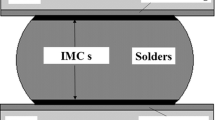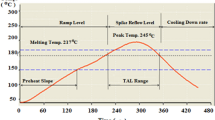Abstract
Leadless chip resistor (LCR) assemblies were manufactured using both traditional tin-lead (Sn37Pb) and lead-free (Sn3.8Ag0.7Cu) solders. The leadfree test vehicles were assembled using three different cooling rates: 1.6°C/sec, 3.8°C/sec, and 6.8°C/sec. They were then exposed to accelerated thermalcycling (ATC) tests between 0°C and 100°C with a 10–14°C/min ramp rate and a 5-min dwell time. The test results indicated that these lead-free solder joints had better creep-fatigue performance than the tin-lead solder joints. The LCR built with the medium cooling rate showed the longest fatigue life compared with the resistors built with the normal cooling rate of 1.6°C/sec and the higher cooling rate 6.8°C/sec. The number of cycles to failure was significantly correlated to the void defect rate. Failure analyses were done using cross-sectioning methods and scanning electron microscopy (SEM). Finite-element models were built to analyze the inelastic, equivalent strain range in solder joints subjected to thermal-cycling conditions with different degrees of solder wetting. The results indicated that poor wetting increases strains throughout the joint significantly, which is in accordance with the ATC results.
Similar content being viewed by others
References
P. Roubaud, R. Bulwith, R. Herber, S. Prasad, F. Carson, S. Kamath, and A. Garcia, Electronic Assembly Process Conf. (Northbrook, IL: IPC, 2001), p. LF2–3.
D.K. Joo and J. Yu, IEEE Electron. Comp. Technol. Conf. (Piscataway, NJ: IEEE, 2002), pp. 1221–1225.
A. Schubert, R. Dudek, H. Walter, E. Jung, A. Gollhardt, B. Michel, and H. Reichl, IEEE Electronic Components and Technology Conf. (Piscataway, NJ: IEEE, 2002), pp. 1246–1255.
C. Kanchanomai, Y. Miyahita, and Y. Mutoh, J. Electron. Mater. 31, 151 (2002).
J.-Y. Park, C.-U. Kim, T. Carper, and W. Puligandla, J. Electron. Mater. 32, 1232 (2003).
H. Rhee, F. Guo, J.G. Lee, K.C. Chen, and K.N. Subramanian, J. Electron. Mater. 32, 1264 (2003).
D. Lewis, S. Allen, M. Notis, and A. Scotch, J. Electron. Mater. 31, 161 (2002).
D. Tian and T. Kutilainen, J. Electron. Mater. 32, 158 (2003).
W.J. Plumbridge, C.R. Gragg, and S. Peters, J. Electron. Mater. 30, 1178 (2001).
S. Wiese, E. Meusel, and K.-J. Wolter, IEEE Electron. Comp. Technol. Conf. (Piscataway, NJ: IEEE, 2002), pp. 197–206.
Y. Qi, H.R. Ghorbani, and J.K. Spelt, Proc. SMTA Int. Conf. (Edina, MN: SMTA, 2003), pp. 735–740.
Research Services Branch, “Image J Download,” http://rsb.info.nih.gov/ij/download.html.
J. Lau, W. Dauksher, and P. Vianco, IEEE Electronic Components and Technology Conf. (Piscataway, NJ: IEEE, 2003), pp. 229–236.
S. Wiese, A. Schubert, H. Walter, R. Dudec, F. Feustel, E. Meusel, B. Michel, IEEE Electronic Components and Technology Conf. (Piscataway, NJ: IEEE, 2001), pp. 890–902.
Author information
Authors and Affiliations
Rights and permissions
About this article
Cite this article
Qi, Y., Zbrzezny, A.R., Agia, M. et al. Accelerated thermal fatigue of lead-free solder joints as a function of reflow cooling rate. J. Electron. Mater. 33, 1497–1506 (2004). https://doi.org/10.1007/s11664-004-0091-0
Received:
Accepted:
Issue Date:
DOI: https://doi.org/10.1007/s11664-004-0091-0




